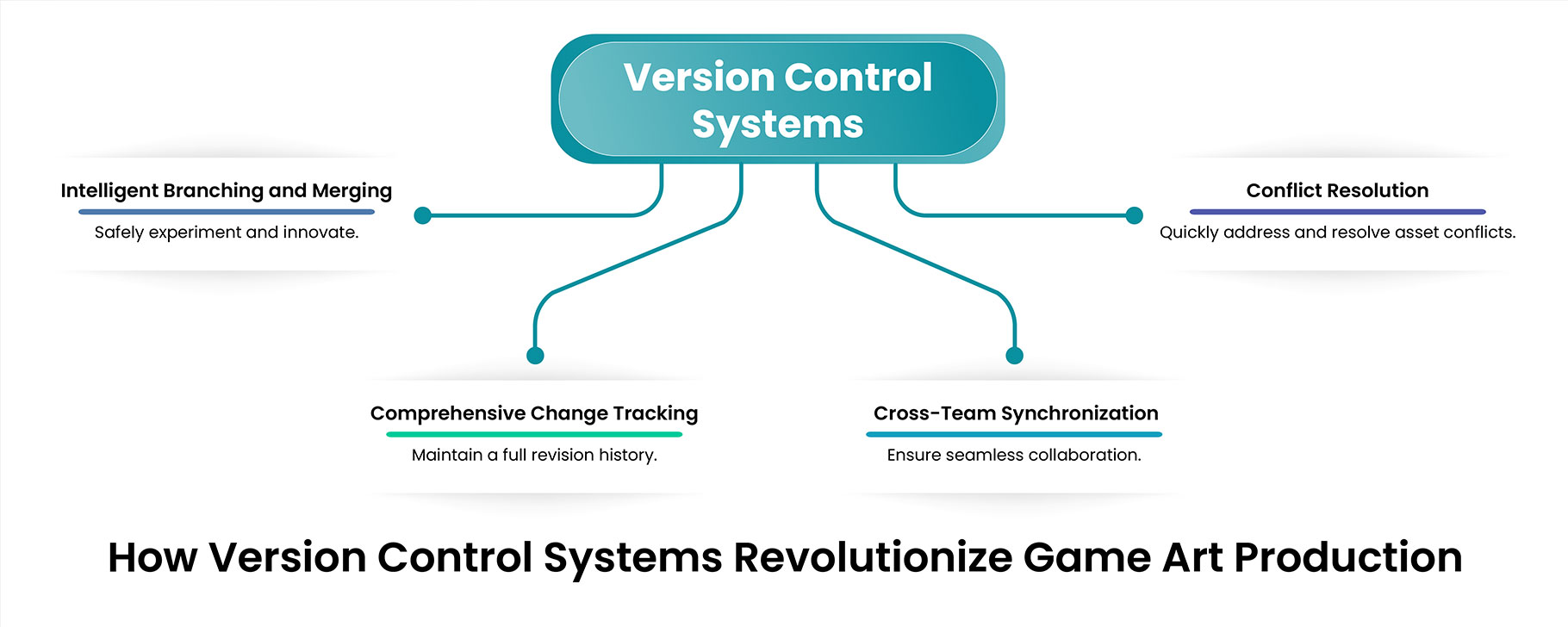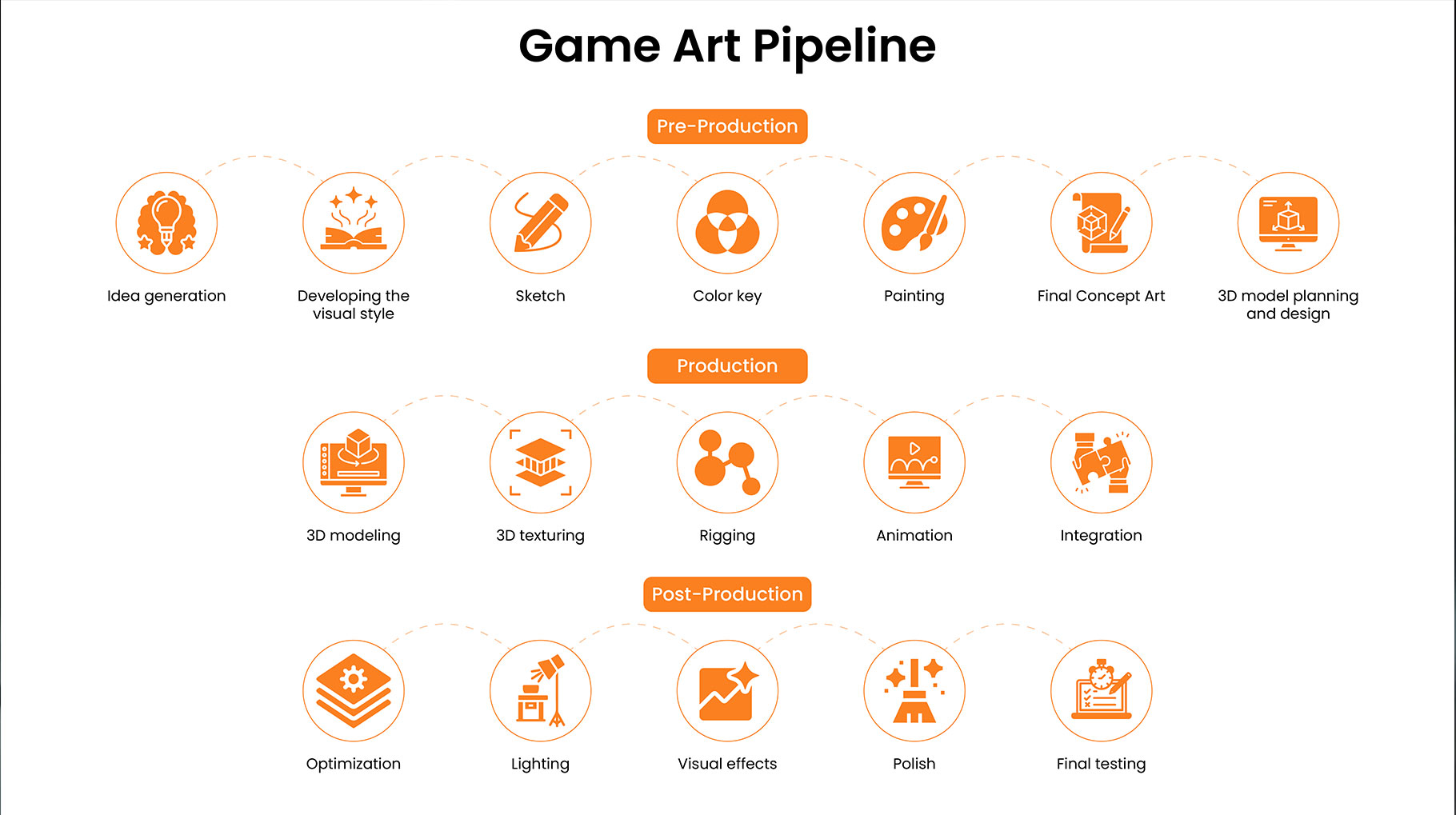Game development is a complex process that involves many different factors, such as collaborative communication, coordination of tasks and resources among multiple teams, and, most importantly, the art and development pipeline. However, one of the biggest bottlenecks in game art pipelines is latency; various issues can cause this and lead to delays in timelines, hindering progress on projects and causing an impact on overall quality standards. Optimizing game art pipelines is required to reduce these bottlenecks, foster better actionable strategies, and ensure teamwork efficiency. This blog will explore strategies to streamline your art pipeline, minimize latency, and help your team achieve their goals faster than ever without compromising quality or creativity.
The game art pipeline is at the heart of this intricate process—a critical infrastructure that can make or break your project’s success. It governs the creation of all visual assets for a game, starting from the initial design concepts and ending with integrating those assets into the finished game. These pipelines generally involve a complex collaboration between multiple teams, including artists specializing in different areas like modeling, texturing, and animation, game designers outlining the visual requirements, and software developers integrating the finished assets into the game engine.
Cross-team collaboration in game development ensures the pipeline runs smoothly, allowing each team to align their work with the overall vision. The entire process is susceptible to delays, or latency, stemming from several sources: misunderstandings between teams, inefficient workflows, and technical problems with software or hardware. Such latency can significantly impact project schedules, resulting in missed deadlines and increased costs.
Optimizing the game art pipeline isn’t simply about maximizing or speeding up production; it’s about creating a smooth and efficient collaborative environment, minimizing costly errors, and seeing that high-quality game assets are delivered on time and within budget. Strategies to achieve this improved proficiency will be analyzed in the following sections:
Effective communication is critical for a successful game development project. This isn’t just about exchanging emails or meeting occasionally; it needs a carefully planned and all-around communication strategy that essentially changes how the development team works together. This approach must cover all aspects of the project, from the initial concept to the final release, guaranteeing everyone is on the same page and working towards the same goals.
Clear, coherent, and timely information flow is crucial for avoiding misunderstandings, resolving conflicts, and maintaining a positive and productive team environment. A well-executed communication strategy directly contributes to the game’s success and reduces potential delays and setbacks. Improving game design collaboration is key to ensuring seamless teamwork throughout development.
| Tools | Features | Strengths | Ideal Use Case |
| Jira | Task tracking, reporting, agile boards | Highly customizable, scalable | Managing complex projects |
| Trello | Kanban boards, task assignments | User-friendly, visual interface | Smaller teams or simpler projects |
| Slack | Real-time messaging, integrations | Instant communication, integrations with multiple tools | Enhancing team communication |
| Microsoft Teams | Chat, video calls, file sharing | All-in-one collaboration hub | Teams requiring integrated solutions |
Comparison of Game Art Collaboration Tools
Version control systems are essential for game art’s efficient and collaborative production. These systems aren’t merely technical tools but crucial strategic frameworks supporting the intricate processes of developing game art. They allow multiple artists to work simultaneously on the same assets, tracking changes, resolving conflicts, and ensuring everyone works with the most up-to-date art versions. This streamlined workflow prevents costly errors and reduces the risk of losing valuable work. They also provide a complete history of revisions, allowing artists to revert to earlier versions if needed and facilitating a smooth and productive team environment.

A well-implemented Digital Asset Management (DAM) system is like a high-tech library for your game’s creative resources. It centralizes the storage, organization, and retrieval of digital assets, ensuring that teams always have access to the latest files. This system ensures that all digital assets – everything from concept art services and 3D models to sound effects and animations – are stored, organized, and readily accessible to the entire development team.
This centralized approach guarantees that everyone is working with the most up-to-date versions of files, preventing confusion and streamlining the collaborative workflow. Such systems greatly enhance game art services, ensuring that all visual elements, whether in early development or final design stages, are easily accessible and well-organized.
| Feature | Benefit | Use Case |
| Metadata Tagging | Faster retrieval and searchability | Organizing 3D models and textures |
| Automated Version Control | Eliminates manual versioning errors | Ensuring asset accuracy |
| Centralized Secure Storage | Provides a single source of truth | Storing and sharing large-scale assets securely |
| Real-Time Collaboration | Facilitates seamless teamwork | Animators and designers working on shared projects |
Key Features and Benefits of Digital Asset Management (DAM) Systems
Automation in game art creation isn’t about eliminating the need for creative artists; instead, it’s designed to enhance their capabilities and productivity. Automating repetitive and time-consuming tasks within the game art pipeline allows artists to focus more on the creative aspects of their work, such as concept design, character modeling, and environment creation.

Modern game development is global. Your game art collaboration tools must bridge the gap between asynchronous workflows. This requires using collaboration tools designed to handle the challenges of asynchronous workflows, where team members work at different times and locations. Effective communication and project management become paramount in these scenarios. These tools must facilitate the seamless sharing of assets, code, and documentation, ensuring everyone stays informed and aligned on project goals despite the geographical and temporal distances. Advanced game art tools and techniques are vital in optimizing game development, enabling teams to enhance their creative output and deliver high-quality results.
Agile methodologies significantly improve game development processes’ flexibility, responsiveness, and optimization. This allows development teams to adapt more easily to player feedback, market trends, and technological advancements.
Creating exceptional game art isn’t just about talent—it’s about building a robust, efficient workflow that transforms creative vision into stunning digital experiences. Here are the critical best practices every game development team should embrace:
A well-orchestrated pipeline is the backbone of successful game art creation. By breaking down the process into clear stages, teams can maintain consistency and quality from concept to final asset.

Chaos is the enemy of creativity. A systematic approach to managing game assets can save countless hours and prevent costly mistakes.
Great game art is a team sport. Breaking down silos between artists, designers, and programmers is crucial for seamless development.
Work smarter, not harder. Automation can dramatically reduce repetitive tasks and free up creative energy.
Perfection is a journey, not a destination. Create a culture of continuous improvement and constructive feedback.
Excellence is in the details. Establish clear standards that ensure every asset meets your studio’s high bar.
Beautiful art means nothing if it doesn’t run smoothly. Balance visual fidelity with technical performance.
Knowledge is a studio’s most valuable asset. Create a living knowledge base that captures your team’s expertise.
At Juego Studios, we specialize in creating streamlined game art pipelines tailored to your project needs. Our experts leverage the latest tools, methodologies, and technologies to ensure efficient cross-team collaboration in game development and high-quality asset delivery. Whether you’re developing a mobile game or an AAA game art, our services are designed to optimize every production stage.
Reducing latency in game art pipelines is a multifaceted challenge, but the benefits are undeniable. By establishing clear communication, leveraging automation, adopting agile methodologies, and optimizing workflows, studios can enhance collaboration, improve efficiency, and deliver exceptional gaming experiences on time and within budget. The future of game development belongs to those who can innovate and collaborate seamlessly.
Delays in game art pipelines, often called latency, stem from several key issues. Communication gaps: Miscommunication between artists, designers, and programmers can lead to a poor understanding of asset specifications, causing delays and rework.
Game studios commonly experience a significant decrease in the time required for asset creation and integration, typically ranging from 20% to 40%. This means that if a project initially took 100 hours for these tasks, it could now be completed in 60 to 80 hours, representing significant time savings and increased efficiency. This efficiency gain can be attributed to improved workflows, advanced tools and technologies, and optimized processes.
The resulting time saved translates directly into cost reduction and allows studios to allocate resources to other critical aspects of game development, like gameplay design or marketing.
Version control systems (VCS), such as Git and Perforce, are invaluable tools for teams working on collaborative projects. These systems enable multiple individuals to work on the same assets simultaneously, significantly reducing the chances of conflicting edits and ensuring a smooth workflow. A comprehensive history of all modifications made to each asset is meticulously tracked, providing a detailed audit trail for every change. This allows for easy rollback to previous versions if needed and aids in tracking down the source of bugs or errors.
This version of history is crucial for collaboration, enabling team members to review changes, understand the evolution of assets, and collaborate effectively on shared projects. The ability to merge changes from different team members minimizes conflicts and helps maintain a consistent and reliable project.
Training teams to embrace new pipeline strategies requires a multifaceted, empathetic approach that balances technical instruction with psychological adaptation. Begin with comprehensive workshops explaining new workflows’ technical aspects and addressing the underlying reasons for change. Create a structured learning path that includes hands-on training sessions where team members can practically experience the benefits of the new strategies.
Develop robust documentation as a reference guide and a learning resource, incorporating visual aids, step-by-step tutorials, and real-world case studies. Implement a gradual rollout strategy, allowing teams to transition incrementally and provide continuous feedback. Establish a mentorship program where more experienced team members can guide others through the transition, creating a supportive learning environment that reduces resistance to change and promotes collaborative skill development.
Artificial Intelligence has emerged as a transformative force in game art pipelines, revolutionizing traditional asset creation and optimization processes. AI technologies extend beyond simple automation, offering intelligent solutions that augment human creativity.
Automation represents a critical evolution in game art pipeline management, addressing fundamental inefficiencies that have historically constrained creative workflows. By systematically eliminating repetitive, manual tasks, automation liberates artists and developers to focus on high-value creative endeavors. Sophisticated automation tools can handle complex processes like asset standardization, batch processing, format conversions, and performance optimization quickly and accurately.
The true power of automation lies in its ability to minimize human error, ensure consistent quality across large-scale projects, and dramatically compress development timelines. Automated testing protocols can instantaneously validate asset performance across multiple platforms, while intelligent routing systems ensure that each asset moves seamlessly through production stages. Moreover, automation provides scalability, allowing studios to manage increasingly complex projects without proportionally increasing human resource requirements, thus creating a more flexible, responsive development ecosystem.
Cross-platform asset optimization has become a strategic imperative in modern game development, requiring a holistic, forward-thinking approach.